 We all have seen a rainbow occasionally in our daily lives during or immediately following a shower of rain and must have wondered the reason for this natural phenomena. Most of us, if not all, as a child must have been excited to see a rainbow in the sky and marvel at its splendid beauty and wondered where it came from. Rainbows have always fascinated humans every since the early days and as such, have been the subject of songs, poems, stories and mythology. In Norse mythology, the rainbow is the road between the worlds of gods and men. The Greeks used to believe that it was a sign from the gods to foretell war or heavy rain.
We all have seen a rainbow occasionally in our daily lives during or immediately following a shower of rain and must have wondered the reason for this natural phenomena. Most of us, if not all, as a child must have been excited to see a rainbow in the sky and marvel at its splendid beauty and wondered where it came from. Rainbows have always fascinated humans every since the early days and as such, have been the subject of songs, poems, stories and mythology. In Norse mythology, the rainbow is the road between the worlds of gods and men. The Greeks used to believe that it was a sign from the gods to foretell war or heavy rain. Indians believed that it was a bridge between life and dead and the Irish believed that a pot of gold lies at the end of a rainbow. It is also mentioned in the Holy Bible in The book of Genesis (Gen 9: 8-17) where the rainbow is the sign of covenant between God and all life on Earth . I’m sure some of us as adults today still have no answer to how a rainbow is formed. Today however, that will be answered by this weeks article. Now let explain this well known phenomena in steps below.
Indians believed that it was a bridge between life and dead and the Irish believed that a pot of gold lies at the end of a rainbow. It is also mentioned in the Holy Bible in The book of Genesis (Gen 9: 8-17) where the rainbow is the sign of covenant between God and all life on Earth . I’m sure some of us as adults today still have no answer to how a rainbow is formed. Today however, that will be answered by this weeks article. Now let explain this well known phenomena in steps below.What is a rainbow?
 A rainbow is an arc of light separated into bands of color (parallel stripes) that appear when the Sun's rays are refracted and reflected by drops of mist or rain. The colors of the rainbow are red, orange, yellow, green, blue, indigo, and violet. These are the full spectrum of colors that make up the sun's white light. Thus, rainbow is a multicolored arc of light in sky.
A rainbow is an arc of light separated into bands of color (parallel stripes) that appear when the Sun's rays are refracted and reflected by drops of mist or rain. The colors of the rainbow are red, orange, yellow, green, blue, indigo, and violet. These are the full spectrum of colors that make up the sun's white light. Thus, rainbow is a multicolored arc of light in sky.An Introduction To Understanding The Color of a Rainbow
{Why is the rainbow colored?}
First to understand why rainbow have colors or how they get their colors, you will need to know that white light is made up of a spectrum of colors that exhibit the characteristics of a wave. To be more specific, white light ( e.g. the Sun’s light) is made up of wavelengths of different colors
 of light (click here to see image). This phenomenon can be explained and was demonstrated by mathematician and scientist Sir Isaac Newton 1642-1727 by letting a beam of sunlight (white light ) passing through a prism. He showed that the sunlight is composed of several different colors, (Red, Orange, Yellow, Green, Blue, Indigo and Violet in that order respectively) that human eye doesn’t see separately.
of light (click here to see image). This phenomenon can be explained and was demonstrated by mathematician and scientist Sir Isaac Newton 1642-1727 by letting a beam of sunlight (white light ) passing through a prism. He showed that the sunlight is composed of several different colors, (Red, Orange, Yellow, Green, Blue, Indigo and Violet in that order respectively) that human eye doesn’t see separately.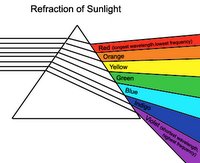 Click on diagram to enlarge
Click on diagram to enlargeThe colors are produced by a phenomenon called dispersion. When white light passes through a prism, it scatters (disperse) the different colors of light according to their wavelength or frequencies, showing a continuous band of colors (called a spectrum) as it travels from one medium (e.g. prism) to another (e.g. air). These different colors of light have all slightly different directions and so display each color components of white light. Thus, the angle of bending is different for different wavelengths of light. This band of colors appears in the same pattern as the colors of a rainbow. This means, all the different colors of light (red, orange, yellow, green, blue, indigo and violet) combine to give you what is called white light. These colors, based on their wavelength, are arranged in the order shown above when they are being scattered. The longest wavelengths of light are on the red end of the spectrum and the shortest wavelengths are on the violet end of the spectrum.
How Rainbows Are Formed/What Causes a Rainbow?
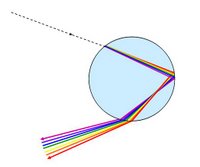
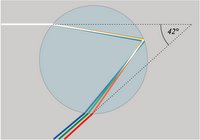
The principle explained above can be applied to how rainbow is formed in the sky. When there are water droplets in the atmosphere for instance, during or immediately following a shower of rain, there will be thousands of these tiny droplets (raindrops) floating around in the air. When light from the Sun encounters a water droplet (spherical in shape), it penetrates the outer boundary of the droplet. As it enters, the light is bent (refracted) and scattered (disperse) into a continuous band of colors (a rainbow of colors). These colors are then reflected from off the back of the drop again as they pass through the front of the drop once more, thus being bent (refracted) still some more. These continuous band of colors as explained above, is due to the fact that the angle of bending is different for different wavelengths of light. This explains the reason for the appearance of the band of colors which is due to their wavelength. There you will always see the colors of a rainbow in the following order of colors; Red, Orange, Yellow, Green, Blue, Indigo and Violet. Red is refracted the least, and violet the most. The other colors are found between these two. Blue light has a shorter wavelength than that of red light because it as a longer wavelength and thus, is refracted more. Therefore resulting a blue light to be located in the inner section of the rainbow and red light to be located in the outer section of the rainbow. This same principle explains the reasons for the order in which the different colors of light appears in a rainbow.
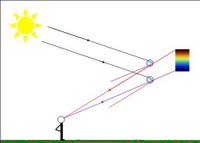 Click on diagram to enlarge
Click on diagram to enlarge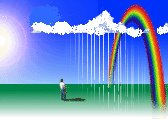 A rainbow is always directly opposite the sun from the observer. That is, the rainbow appears in front of the observer, whose back is to the sun. Therefore the rainbow that the observer will see in the sky will caused by thousands of water droplets acting like thousands of tiny prisms resulting the different component colors of white light (sunlight) to be displayed. Each falling water droplet (raindrops) flashing its colors to the observer for just an instant, before another drop takes its place letting the rainbow appearance remain constant to the observer. The rainbow's location will appear different for observers at different locations, but it is always directly opposite the sun. This means another observer will not see the rainbow if the sun is not behind that person. So, it will all depend on the angle of the Sun in the sky in relation to where you are, providing that enough water droplets are in the atmosphere for you to see this effect. This will not work if the sun is directly over head. Looking on the diagrams you will see why rainbows are only seen when the sun is low in the sky, usually in the late afternoon. It is also important to note that the rainbow is light reflected to the eye at an angle of 42 degrees to the original ray of sunlight. This implies that when we see a rainbow at the 42 degree angle, it is measured from each observers eye thus therefore, no two persons will see exactly the same rainbow.
A rainbow is always directly opposite the sun from the observer. That is, the rainbow appears in front of the observer, whose back is to the sun. Therefore the rainbow that the observer will see in the sky will caused by thousands of water droplets acting like thousands of tiny prisms resulting the different component colors of white light (sunlight) to be displayed. Each falling water droplet (raindrops) flashing its colors to the observer for just an instant, before another drop takes its place letting the rainbow appearance remain constant to the observer. The rainbow's location will appear different for observers at different locations, but it is always directly opposite the sun. This means another observer will not see the rainbow if the sun is not behind that person. So, it will all depend on the angle of the Sun in the sky in relation to where you are, providing that enough water droplets are in the atmosphere for you to see this effect. This will not work if the sun is directly over head. Looking on the diagrams you will see why rainbows are only seen when the sun is low in the sky, usually in the late afternoon. It is also important to note that the rainbow is light reflected to the eye at an angle of 42 degrees to the original ray of sunlight. This implies that when we see a rainbow at the 42 degree angle, it is measured from each observers eye thus therefore, no two persons will see exactly the same rainbow.Secondary Rainbow
Another larger rainbow (double rainbow) is often seen outside the primary rainbow (that which we just explain) and runs parallel to it. This secondary rainbow is produced in a similar way as explained above but in this case, the sun's light is reflected twice internally before emerging from the water droplet (raindrop). Thus, resulting in a sequence of colors that are reversed. This secondary rainbow colors are not as bright as the primary rainbow.
The Bow (Arc) Shape of a Rainbow - Why are rainbows in an arc shape?
When we see rainbows it usually appears as an arcs shape. However, rainbows are formed as a circle. The light from the sun is being refracted (bent) by the droplets over a certain angle (about 42 degrees) .This angle is so big that the rainbow appears centered on the point opposite the sun. This point is called the antsolar point that the rainbow seems to form around {Click to see Diagram}. The bow shape is actually part of a circle of light that is cut off by the horizon that obstruct it. Thus, the lower the sun is in the sky the more one will be able to see more of the rainbow (a larger bow). It is however possible to see the full circle of a rainbow at a high altitude such as in an aero plane. This is due to the fact that the horizon do not block the observer point of view.
Related Articles:
The Meaning of Colors - Color Symbolism
Why are traffic lights Red, Yellow and Green?
Why leaves change color in fall?
What causes hair to turn gray?
Why do people have different colors of skin?
Why is the sky blue?
I love rainbows.
ReplyDeleteWhat the rainbow shows me is the colours of the beauty in diversity of all humankind.
Cheers!
Brutus:
ReplyDeleteI’m glad that you not only found the article interesting but that it allows you to recollect your childhood :)
Thank you very much for the comment and for stopping by. Hope you will stop by again :)
Orikinla:
Well said my friend, there is beauty in diversity. God made all the colors of the rainbow from white light just as how he made us all diverse and beautiful belonging to one human race. We are diverse but are wonderfully made, perfect and whole as one race. From the white light we get different colors where no color is superior over the other. Reversing these rainbow colors will in turn harmonize to give us a single white light.
Have a wonderful day.
You have a very attractive site. You do have varied interests, don't you? Everything seems to be well researched and clearly written. Do you take requests for topics?
ReplyDeleteI'm here from Blog Village.
Hi! I am using the information on this blog about rainbows for a project. I really wonder who would have such an interest to even post it on a blog!! And yeah,I think rainbows are awesome. After almost every rain or drizzle I'd look out the window to see if there is any rainbow in the sky.
ReplyDelete:)
Good blog !!!
ReplyDeleteHey! Awesome information - thankyou!!
ReplyDeletethis is wiiked its reli helped mee wiv my science project thankooz xxx
ReplyDeleteThx so much 4 the info. It'll help me so much on my science project, and believe me, I will be coming back on this site! :)
ReplyDeletethanx so much its really helped with my physics essay
ReplyDeleteThis information really helped me with my science project! I aced it! Wohoooo!!! Thanks!!
ReplyDeleteI like Rainbows!!
ReplyDeleteI love rainbows. it shows love surrounding you.its greeat,
ReplyDeleteFiiNALLY ii F0UND SUMTHiiN 0F RAiiNB0WS!!!=] THANKZ F0R PUTTiiN THiiS iiN THERE N N0W ii CAN FiiNiisH MY HW!!!!![iiTS B0UT H0W RAiiNB0WS R MADE]
ReplyDeleteWow! i always wondered how rainbows were made! Thanks for your info! Rainbows are so pretty!
ReplyDeleteThanks for this!!!!! This website might just be all I need to complete my whole Science Fair Project!!!!
ReplyDeletei will kill your family
ReplyDeletei love flipping rainbows!!!!!!
ReplyDeleteExtremely Informative!!! Enjoyed the article!!!
ReplyDeletethanks needed info for assignment
ReplyDeletenice blog!!!!!!!!:)
ReplyDeleteHelpful advises above. I have noticed that many people are using twitter for marketing. I would love to try this too for my business.
ReplyDeleteThanks for sharing the ways on how to do it. I have a small business and I use social media. I'm the only one who maintains it, I do the blogging, the articles, etc. And I always seek for an online advise and tips. And I find your blog so useful and helpful.
ReplyDeleteIm a teenager and I've learned about light refraction and reflection. From what I was told, the light bounces off water particles and they reflect different colours, just like glass.
ReplyDeleteEither way, I <3 rainbows. Amazing nature magic as I call it!
This Blog is going places, the people, the layout, amazing to see such dedication and focus.
ReplyDeleteThis comment has been removed by the author.
ReplyDeleteNice article but i got my little doubts about the perfect position of rainbows. They stay unmoved up there, making it hard to understand why concurrently replacing droplets of water under other physical influences would be enough to keep it in place. Also is there a reason why all the refracted color units form one large piece. What is the actual reason for this perfect order?
ReplyDeleteIt is you who determines the position of the rainbow. Imagine the rainbow as a full circle, the centre of that circle will be directly opposite your head from the sun. The reason for seeing each colour in a stationary position is that it's only at that particular angle (from sun to water droplet to your eyes) that your eyes receive the reflection of that particular colour. i.e. at an angle of 42 degree red light will reflect back to your eyes, all other colours of the spectrum ( which reflect back at a lower degree) will pass above your head and you won't see them. So it is only possible to see the red light at that particular position. Same for each colour, they'll only reflect back to your eyes at a particular angle in relation to your head and the sun.
DeleteIts very poor
ReplyDeleteBack when I was a kid, we, along with my friends always wait for the rainbow to show up after the rain is gone. Looking at the rainbow gives that relaxation and inner peace.
ReplyDeletePlease prove you're not a robot
ReplyDeletetiny correction:
ReplyDeletein the last paragraph, the word "antisolar" is missing the "i".
thanks!
Do see my blog to it is bit small info just as small blog
ReplyDeleteHi, universalfacts.com, You have a greate article, I really like to read this article, Thanks for sharing this article, I hope this article will be help full for your blog reader, if you need to know about Satta Matka then please visit our website
ReplyDeleteHi, universalfacts.com, You have a greate article, I really like to read this article, Thanks for sharing this article, I hope this article will be help full for your blog reader, if you need to know about Matka Play then please visit our website
ReplyDelete